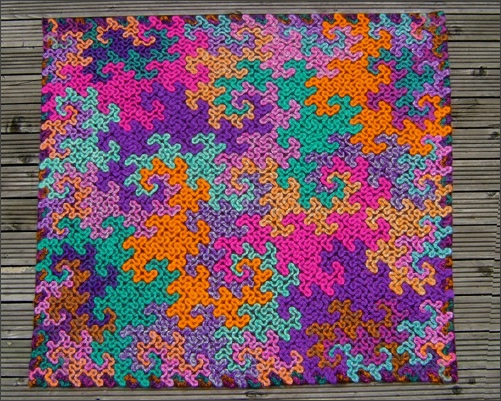




The real new millennium began. This was 2001, not 2000 and, with three mathematicians now in the house we would have argued this point with anyone. Ben came to stay for a few months. He isn’t really a mathematician. He is a physicist, putting maths, and other things, to a practical use. He had always been involved in the design and creation of the afghans and was instrumental in informing the world of what we were doing, via the web site. Little did he know, when he came to stay, that our afghan designs would play a part in where his path through working life might begin.
For the Chinese, 2000 had been the Year of the Dragon. For us 2001 was dragon year. Early in the year, I had to invigilate in a school exam. According to the regulations, exam invigilators should not do anything other than give their entire attention to the students they are supervising. This was an exam with six or seven candidates who were spread around a classroom full of desks. I was there for two hours. There was no room to walk about without disturbing them and nothing to relieve the boredom. An invigilator is in grave danger of falling asleep in such circumstances so I took my trusty Curious and Interesting Geometry with me. I had looked at the pictures in this book so many times before it is difficult to believe that I could find something new. I had recently been crocheting, rather than knitting, and perhaps I was looking from a different perspective. Dragon Curves entered my consciousness and I couldn’t wait to get home to look at them in more detail. When I did we were all hooked and an addiction began.
The concept is so simple but the potential is amazing. Take a long strip of paper and fold it in half. You get a strip of paper with a fold in it! Refold the paper then fold it in half again. When you look inside you have two folds going in one direction and one fold going the other way. Refold and fold in half again and, when you unfold, you get even more folds, some going one way, some the other. Keep a record of where the folds occur after each folding and it becomes obvious that a pattern is being formed. It becomes possible to predict what will happen with the next folding. In real life, the strip of paper can only be folded about six times before it gets too thick to bend. Mathematically, you can go on folding the strip as many times as you want.
These folds are interesting in themselves but the patterns the strip creates are even more intriguing. Unfold the strip and make a firm crease along each of the fold lines, taking care to maintain the correct direction for the fold. Stand the strip on its edge, with each fold forming a 90 degree angle, and look down on it. You will see an intricate pattern of squares, and twists and turns. The strips get the name of Dragon Curves because, after a few folds, they start to take on the appearance of a dragon with large head, legs and tail.
These are space-
Steve was fascinated and spent his time drawing dragons, using various computer programs
to make the task a little easier. Ben ventured into the deeper realms of changing
the angles of the folds in the strip. This is almost impossible in a real-
Another aspect of mathematics came into play. According to the Four-
The grid was tedious to make but the prospect of adding the dragons was a spur to
finish it quite quickly. The yarns were chosen. It was to have four basic shades
of mohair – orange, bright pink, vivid turquoise-
Completing the first dragon was a nightmare. The background had to be turned for every section of dragon, which was 512 times for the largest! Once the first one was in place it got much easier as mistakes were obvious when dragons didn’t fit snugly together and any errors were easily pulled undone. It wasn’t long before everyone wanted to have a go at adding the stitches. The process was so easy anyone could do it after one minute’s tuition. It was finished in no time and was the most spectacular thing we had ever created. We could have stopped there but the obsession had taken over and we went on, searching for anything with a square grid that could have dragons applied to it.
There was another afghan using the same design as the first but in just four colours – red, black, silver grey and dark grey – with no regard for the different orders of dragons. We made scarves and rug and bags and anything else we could think off, with various combinations of dragons. I have always wanted to add dragons to someone’s chain link garden fence, using strips of carrier bags, but I haven’t found a suitable place – yet. The afghans went into a booklet entitled Scaled Up, the smaller items became Scaled Down. Mainly for our interest, and to remember what we had discovered, we wrote another booklet, Dragonometry, which was purely about the mathematics involved. Much to our surprise we sell as many copies of that booklet as the others, even to knitting and craft groups.
We really were addicted to dragons but you may be wondering why this was such a significant
time for Ben. Firstly, the booklet of instructions for these afghans was a little
different from the others. It said ‘Designed by Steve Plummer & Ben Ashforth. Created
by Pat Ashforth’. It was the first time Ben had his name on a booklet. More importantly,
he went for an interview as a Research Scientist, at a highly-
